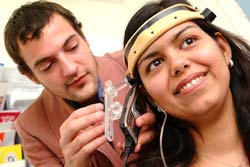Study to assess the effects of mobile phones on hearing nears end of first phase

Testing the effects of mobile phones on hearing: University researchers Nathan Thomas and Mona Mahmoud
Scientists at the Institute of Sound and Vibration Research (ISVR) at the University of Southampton are nearing the end of the first phase of a study to assess whether the use of mobile phones has any adverse effect on the hearing of healthy young adults.
The study into Potential Adverse Effects of GSM Cellular Phones on Hearing (known by the acronym GUARD) is part of a joint European project funded by the European Commission being carried out simultaneously in several countries across Europe. The aim is to confirm that the low-intensity electromagnetic fields used by mobile phones have no measurable effect on the human hearing system.
The Southampton study involves testing the hearing of 30 healthy young adults and is led by Professor Mark Lutman, Head of Hearing at ISVR.
‘Recent media reports on the effects of mobile phones on the brain have caused anxiety among mobile phone users,’ comments Professor Lutman. ‘There is currently no evidence to suggest that the electromagnetic fields produced by these phones have any measurable effects on a person’s hearing. The most we expect is possibly a small amount of localised heating to the head while the phone is being used. However, this is the first study of its kind on humans, so we are open to new evidence.’
The experiment is being carried out in two parts. The first will involve exposing the participants to mobile phone electromagnetic fields at frequencies of 900 and 1800 MHz for a short period of time in order to investigate whether such short term exposure has any measurable effect on hearing. The second will compare hearing thresholds between groups of frequent and infrequent mobile phone users.
The exposure consists of speech at a typical conversational level delivered via a tube to one ear, plus the specified phone radiation exposure at the normal output of a popular mobile phone model at full power for ten minutes. The results of the first phase of the study will be available in December
The GUARD project brings together a European multidisciplinary research consortium with expertise in physics, engineering, biology and medicine. The research team also sought independent advice from Professor Alan Preece at the department of Medical Physics at the University of Bristol, who confirmed that exposure levels in their experiments are within national guidelines for exposure to non-ionising radiation.
Media Contact
All latest news from the category: Communications Media
Engineering and research-driven innovations in the field of communications are addressed here, in addition to business developments in the field of media-wide communications.
innovations-report offers informative reports and articles related to interactive media, media management, digital television, E-business, online advertising and information and communications technologies.
Newest articles

Superradiant atoms could push the boundaries of how precisely time can be measured
Superradiant atoms can help us measure time more precisely than ever. In a new study, researchers from the University of Copenhagen present a new method for measuring the time interval,…

Ion thermoelectric conversion devices for near room temperature
The electrode sheet of the thermoelectric device consists of ionic hydrogel, which is sandwiched between the electrodes to form, and the Prussian blue on the electrode undergoes a redox reaction…

Zap Energy achieves 37-million-degree temperatures in a compact device
New publication reports record electron temperatures for a small-scale, sheared-flow-stabilized Z-pinch fusion device. In the nine decades since humans first produced fusion reactions, only a few fusion technologies have demonstrated…





















